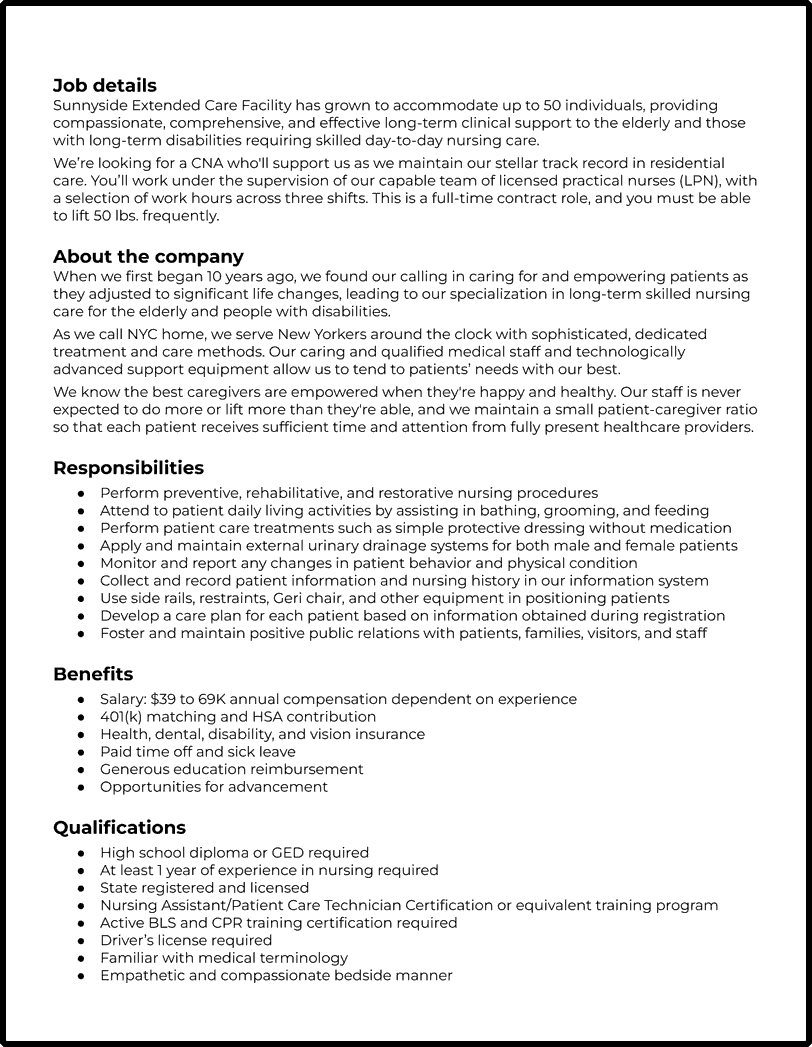We assume you’re here because you’re eager to offer outstanding health services and improve patient care by bringing a CNA on board to round out your team. Great CNAs are empathetic and efficient, with an unflappable demeanor and stellar bedside manners, regardless of the situation. They’re also physically capable, adaptable, and resilient in the face of potential healthcare emergencies, as they must adjust to a patient’s needs in a pinch.
Finding an excellent CNA might not be easy, but we’ve got you covered. We’ll guide you through writing a job description and give you CNA job description examples for inspiration so that you can hire the best fit for your needs.
Craft a Hearty CNA Job Description

CNA roles are very comprehensive, and a one size fits all approach to writing a CNA job description just isn’t going to cut it for the vastly different needs of each medical institution. In the same way that patient records help inform healthcare providers of the next appropriate action, job descriptions inform potential hires of key details such as who the company is, the teams they’ll work with, and the problems they’ll help solve.
Bad grammar, formatting errors, and long, convoluted qualifications lists will only confuse and even repel prospective hires—avoiding these common mistakes will help keep your ideal candidate from slipping away.

Be mindful of who you need on your team and why
As you begin writing your CNA job description, think about why you’re hiring one in the first place. Some questions to consider include the following:
- What are the issues your company is facing, and will this new hire help to resolve them?
- Are your existing nurses bogged down with heavy patient ratios, and is the new CNA meant to help relieve some of the load?
- Is patient care falling by the wayside due to increased patient demand?
Certified nursing assistants do many things, but there are some common traits that almost all CNAs have, such as resilience, attention to detail, the ability to adapt quickly to health emergencies, and a caring bedside manner. These key areas should be written into the job description to reflect the values and qualities you’re looking for in a prospective hire.
- Relationship building
- Time management
- Attention to detail
- Critical thinking
- Collaboration
- Excellent communication
- Leadership

Revise and refine for a healthy job description
Resist the temptation to brain dump—you wouldn’t dump a bunch of patients into your CNA’s lap (you really shouldn’t, at least), and so you shouldn’t do so with your job description, either.
A healthy job description highlights the role’s minimum requirements so potential hires can quickly determine if they’re qualified. Add a couple of nice-to-haves if you like, but make sure your job description is revised and edited before posting; your new hire will get their first impression of your organization through this document!
Get Your Writing Juices Flowing by Outlining Your CNA Job Description

Here’s an outline to help you snag your ideal candidate and get those CNA resumes rolling in!

Job details
In your introduction, tell the applicant about your organization and the role they’ll be taking on. While you should be brief, make sure to disclose key job details—the main questions an applicant will ask that should be answered here are:
- Who are you?
- What are you looking for?
- Why should they work for you?

About the company
This part tells prospective applicants about your organization. Like how patient records give CNAs complete information to work with, add details about your company’s goals, mission, values, and work culture, so your new hire can assess and later adjust to and meet your patient’s needs in the new work environment.

What you’ll be doing
This section is where you’ll note a list of the things the applicant will do after they’ve been hired. Since CNA roles are both technical and comprehensive, being specific and transparent about your expectations will help you find someone who fits you well.
This list of responsibilities should be short and simple, with minimal jargon or complex terminology. Use active verbs in your description to help form a clear picture of the duties required in this role.
- Monitor and report any changes in patient behavior and physical condition, as well as record nursing assistant interventions performed
- Perform rehabilitative nursing procedures for patients such as transfer, ambulation, range of motion
- Engage appropriate body mechanics and operate equipment safely by following Safe Patient Handling procedures and training
- Maintain a safe and efficient work environment and conduct nursing activities while being informed by nursing ethical principles

Qualifications
Here, include the basic requirements a candidate must have, such as education, experience, certification, and specialized requirements like a state nursing license. This is one of the most essential parts of a job description, so make this section clear, concise, and easy to read.
If you’re using relevant personality words like “resilient,” “adaptable,” and “detail-oriented,” that’s great, but take care not to overuse them.
- At least 1 year of experience in nursing required
- Nursing Assistant/Patient Care Technician Certification or equivalent training program
- Familiar with medical terminology
- Empathetic and compassionate bedside manner

Benefits
As long as this section isn’t the introduction, it can go anywhere in the job description. You can move this section further up if you have particularly sweet benefits. When you list your perks, be specific, clear, and transparent—anything mentioned here is a selling point that’ll help you attract the right candidate.
Roles and Rounds Inside the CNA Field

Certified nursing assistants bridge any gaps between patients and medical service providers—whatever needs doing, they’re there to do it. Since they help keep a healthcare organization’s gears running smoothly, they often possess a comprehensive skill set encompassing both technical and non-technical skills on top of their existing nursing qualifications, such as patient information management, resource management and organization, and customer service.
Below are some of the responsibilities a certified nursing assistant might take on. Since every organization is different, a single CNA might not fill all these roles, but this is a sampler.

Customer service liaison
Certified nursing assistants are often invaluable points of contact between medical staff, patients, and family members. This can be challenging as medical emergencies can be frightening; CNAs need to have grace, resilience, and strong communication skills to help put patients and their families at ease as they undergo treatment.
- Orient patients as they join us and begin treatment
- Brief and orient patients who join the institute for the first time
- This role requires a caring and empathetic bedside manner.

Records and secret keeper
Medical care providers often need additional patient information when they dispense treatment, as some patients can be allergic or sensitive to specific substances. Certified nursing assistants help by collecting and recording important medical information such as height, weight, and past medical history.
- Monitor and report any changes in patient behavior and physical condition, as well as record nursing assistant interventions performed as part of the patient’s clinical record
- Assist in developing a care plan for each incoming patient based on information obtained during registration
- This role requires organizational skills, patient information confidentiality, HIPAA compliance, and attention to detail.

Caregiver/nurturer
Some patients require long-term care or specialized assistance with movement, grooming, bathing, and feeding. A CNA helps patients with these needs by assisting with daily living activities, with the eventual goal of caring for themselves independently.
- Perform preventive, rehabilitative, and restorative nursing procedures such as active or passive range of motion (ROM) to support patients as they achieve independence
- Attend to patient’s daily living activities by assisting in bathing, grooming, and feeding to enable the patient’s independence
- This role requires skills and traits like empathy and consistency.

Smart lifter
Bed sores are a serious issue for patients who aren’t turned often enough in their beds, and those in rehabilitation centers need lots of movement to heal; a great CNA may not be a bodybuilder, but they should be fit enough to lift 50 lbs. frequently. Sometimes, they even have to lift 100 lbs.—it all depends on what each patient and organization needs.
- Use side rails, restraints, Geri chair, and other equipment in positioning patients
- Engage appropriate body mechanics and operate equipment safely by following Safe Patient Handling procedures and training
- This role often requires training to safely lift and move another person using body mechanics and machinery.










